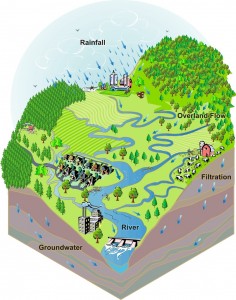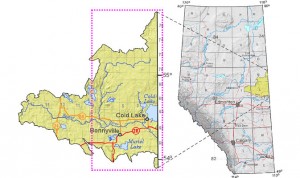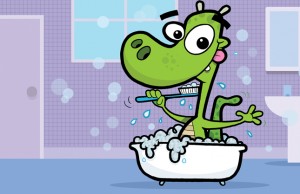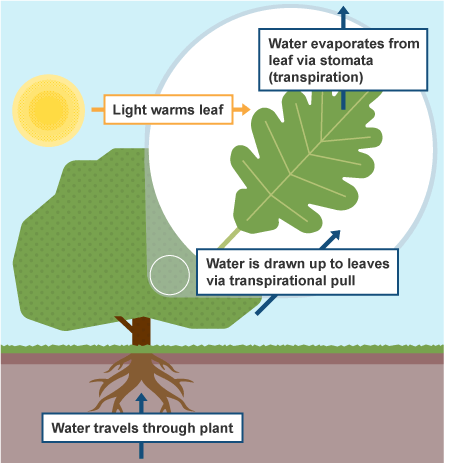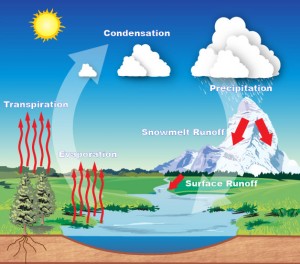Did you know that both the Earth and the human body are comprised of 70% water? This makes water one of our most important resources. Although we all need water to survive, we don’t always stop to think about where our water comes from. By understanding the processes involved in the water cycle, we can all learn how to better protect our watersheds! Explore this page to learn more about Watersheds, the Hydrologic Cycle, and Groundwater!
Watersheds
Watersheds are the source of all water that we use. When you turn on the tap, or fish out on the lake, you are using your watershed. Watersheds are important for a variety of different reasons. To begin with, watersheds provide us with all of our drinking water. Canadian watersheds store 20% of the World’s fresh water supply. Watersheds are also the place in which we live. When we have fun canoeing or cross-country skiing, we’re spending time in our watershed. Additionally, watersheds provide critical habitat for wildlife so we can continue to fish, hunt, and enjoy nature. If you would like to learn more about watersheds, check out this video.
Watersheds come in a variety of different shapes and sizes. The Beaver River Watershed is home to over 38,000 people and occupies 3% of Alberta. Thirty percent of all of Canada’s water, including the water within the Beaver River Watershed, eventually drains into the Hudson Bay. This is one of the many reasons why it is so important to look after our water resources here, because it will affect our friends in Saskatchewan and Manitoba!
Now that you know what watersheds are, try exploring a watershed to see what types of creatures live there and what you can do to protect your own watershed! Think you have what it takes to stop water pollution? Become a water detective and analyze water samples to see what may be polluting our watersheds! If you would like to learn how to conserve water, try this game to learn ways we can all become better watershed stewards.
Did you know that the same water you drink from your tap could also have been the same water that dinosaurs bathed in over one hundred million years ago? That’s because all water belongs to the hydrologic cycle, which is why after 4.5 billion years we still haven’t run out of water!
The hydrologic cycle is the continual recirculation of water through various steps powered by energy from the sun. Take a look at the diagram below to learn all about the hydrologic cycle!
Let’s start with evaporation. Evaporation occurs when a liquid changes into a gaseous state. An example of evaporation is when you boil water. When the water in the pot bubbles and turns into steam, you are watching the water evaporate. In the hydrologic cycle, water from the ocean, soil, streams, and vegetation, is heated by the sun and is evaporated into the atmosphere, turning water from a liquid into a gas.
A very important part of the evaporation process is transpiration. Transpiration occurs when plants absorb water from the soil, and the water travels up through the roots of the plant and into the leaves. When the water reaches the leaves of the plant, some of it is heated up and evaporated by the sun. This results in the very important process that we now know as transpiration.
When water evaporates into the atmosphere, it becomes an invisible gas known as water vapour. When the water vapour reaches the atmosphere and begins to cool, it transforms into liquid water droplets and forms clouds; this is known as condensation. Clouds represent a very large collection of extremely small droplets of water. Because these droplets are so tiny, they are able to float in the air. When the temperature and atmospheric pressure form the right conditions, these small droplets of water in clouds transform into larger droplets and fall from the clouds towards the Earth as rain. This process is known as precipitation.
If you’ve ever watched a rainstorm and tried to follow a single drop of rain, it’s incredibly difficult to determine where that tiny rain drop will end up. Precipitation has many different ways of returning to Earth. Not all rain drops that fall from clouds return directly to the ocean. Some rain drops will seep into the ground through the soil and rock layers. This process is known as infiltration. When the rain water runs off the surface of the land and travels down into rivers, lakes, and the ocean, this process is known as surface runoff.
The final way in which precipitation returns to the Earth is via percolation. In the morning when you watch your mom or dad make a cup of coffee, you may have watched as the steaming water flows through the coffee beans, past a filter, and down into a mug. This process is known as percolation, and is similar to how rain drops end up as groundwater. Gravity pulls the raindrops through rocks and soil until eventually they cannot travel down any further and they become part of an aquifer. Groundwater moves extremely slowly and may take hundreds of years to reach the ocean where it will begin the hydrologic cycle all over again!
If you would like to watch the hydrologic cycle in action, watch this short animated video. If you’d like to learn more about the hydrologic cycle, let Bill Nye guide you through all the steps using a tiny staircase, wind-up penguins and even a bicycle! See how he does it in this hilarious video.
Groundwater
Have you ever gone to the beach or lake and dug a hole in the sand? If you’ve ever dug a deep enough hole, the bottom of your hole will begin to fill up with water. That water is known as groundwater. The term groundwater is aptly named as it is water that comes from the ground. Water from lakes, rivers and streams is called surface water because it is water that comes from the surface. Many people get their drinking water from groundwater via wells.
Like to word-searches? Try finding all of the words in this groundwater wordsearch!

